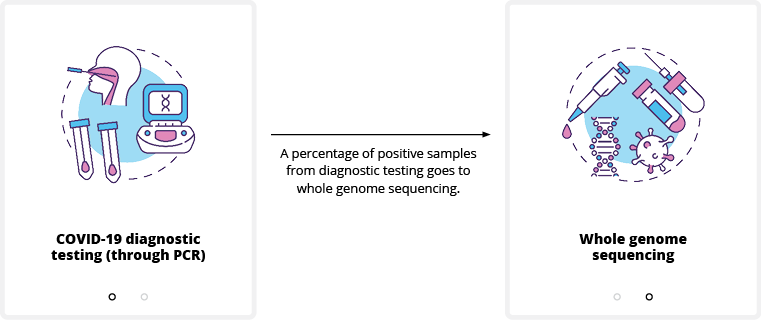
Laboratory Testing to Monitor for COVID-19 Variants
Ontario has a robust surveillance system for monitoring current variants circulating in Ontario and for detecting and identifying new and emerging variants.
Testing for COVID-19 Variants
Does Ontario have a surveillance system for monitoring SARS-CoV-2 variants?
Ontario has a robust surveillance system for monitoring current COVID-19 variants circulating in Ontario and for detecting and identifying new and emerging variants, including the Omicron (B.1.1.529) variant. The Ontario COVID-19 Genomic Network (OCGN), which includes the labs at PHO, Sick Kids, Kingston General Hospital, Shared Labs and Hamilton Health Sciences, is continuing to actively monitor for all potential variants circulating in the province.
- 100% of positive samples will continue to be sequenced through whole genome sequencing as per current provincial surveillance activities. This percentage should provide a representative sample of the characteristics of the tested population.
What types of SARS-CoV-2 variants does PHO look for? What is the difference between a variant of interest and a variant of concern?
Viruses change and mutate as part of their normal evolution. When there are many mutations in the genetic code of a virus, this is called a variant. As with other viruses, variants are common with SARS-Cov-2 (the virus that causes COVID-19). Although many variants will have no difference in the ability to spread or cause more severe disease, some variants have changes (mutations) which may become concerning.
A variant of concern (VOC) is a variant where its changes have a clinical or public health significance that affects one or more of:
- spread (transmissibility)
- severity of disease (virulence)
- vaccine effectiveness
- diagnostic testing
VOC identified globally and in Ontario include:
| World Health Organization label |
PANGO lineage* |
|
Alpha |
B.1.1.7 |
|
Beta |
B.1.351 |
|
Gamma |
P.1 |
|
Delta |
B.1617.2 |
| Omicron | B.1.1.529 |
*Includes all sub-lineages. For a full list of sub-lineages, please refer to our SARS-CoV-2 Whole Genome Sequencing in Ontario report.
A variant of interest (VOI) is a variant that may share one or more mutations in common with a VOC, but do not have enough evidence at this time to be considered a VOC.
Current VOI identified globally and in Ontario include:
| World Health Organization label |
PANGO lineage* |
|
Lambda |
C.37 |
|
Mu |
B.1.621 |
*Includes all sub-lineages. For a full list of sub-lineages, please refer to our SARS-CoV-2 Whole Genome Sequencing in Ontario report.
The province’s laboratory testing and surveillance strategy includes identifying and monitoring both VOC and VOI.
To learn more about the new naming conventions for VOC and VOI, check out the World Health Organization’s webpage: Tracking SARS-CoV-2 variants.
How does the province test for COVID-19 and screen for variants?
The laboratory testing and surveillance strategy includes the following key components:
- COVID-19 diagnostic testing (through PCR): the test that tells us if someone currently has COVID-19 by looking for even the smallest amounts of the virus’s genetic material.
- Whole genome sequencing: a laboratory process (called sequencing) that looks into the makeup of a virus by reading its entire genetic code. Sequencing the SARS-CoV-2 virus allows us to learn more about the virus, how it’s spreading and how it’s changing (emerging VOC and VOI).

Whole Genome Sequencing
What is Whole Genome Sequencing?
Whole Genome Sequencing (WGS) is a significant tool that helps us understand the evolution and spread of the SARS-CoV-2 virus and can inform outbreak control policies and best-practices.
This laboratory process provides an accurate genetic profile or fingerprint that can detect VOC and VOI, and help understand the relatedness between cases.
What is the process for WGS?
The process involves 4 steps:
- A positive viral sample is treated with chemicals to release the genetic material (also known as DNA and RNA), which is then purified.
- Scientists make copies of multiple overlapping regions of the genome, an organism’s complete set of DNA or RNA, using PCR. The copies are referred to as a “DNA library”.
- The DNA library is loaded into a machine, called a sequencer that allows us to look closer into the DNA makeup of the virus. The result is referred to as “DNA read”.
- The sequencer produces millions of DNA reads and through specialized computer programs they are put together in order. When the process is complete, the genome sequence is ready for further analysis.
Who conducts WGS in Ontario?
Ontario has a robust surveillance system for monitoring current variants circulating in Ontario and for detecting and identifying new and emerging variants. The Ontario Whole Genome Sequencing Network (OCGN) was established in March 2021 in response to the emergence of COVID-19 variants with the goal of providing timely surveillance of known and emerging variants. The OCGN is comprised of representatives from clinical and public health laboratories undertaking genomics testing, government, public health and research centres.
The OCGN coordinates the delivery, advancement and understanding of genomics to support the response to the COVID-19 pandemic through building capacity for genomics testing in Ontario. It also supports the application of genomics to inform public health action.
Variant Data and Reporting at PHO
Where can I find information and data on COVID-19 variants?
PHO has been working closely with partner labs that perform genome sequencing in Ontario to build and streamline the process of gathering information and reporting on VOCs. We have a series of routine reports and tools where you can find more information, including:
- SARS-CoV-2 Whole Genome Sequencing in Ontario: An enhanced epidemiological summary that includes data on variants of concern, variants of interest and other variants being seen in the province.
- Integrated Respiratory Virus Risk Indicators for Ontario: A report that provides short-term projections of SARS-CoV-2, influenza, and respiratory syncytial virus (RSV) activity and risk of related severe viral respiratory disease in the pediatric and general adult populations in Ontario.
Don’t have a MyPHO account? Register Now

